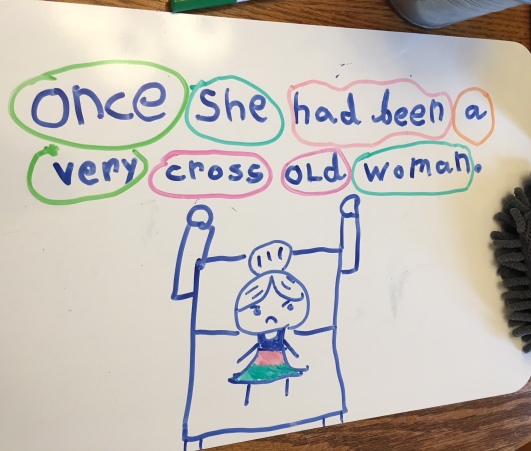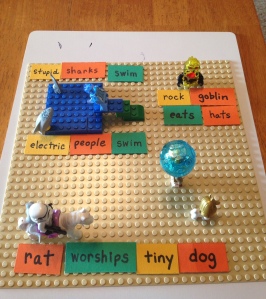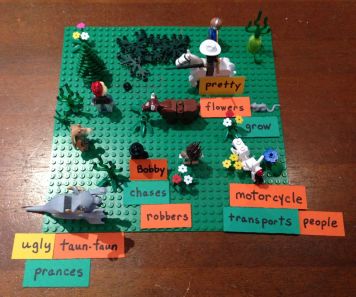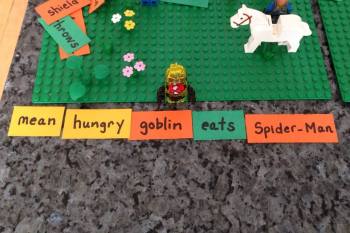As my son (age 13) starts Latin this year (with The Lukeion Project), I am out of the grammar business with him, and starting anew with my two youngest. I’ll post about our grammar progression at a later date, but I really enjoyed these “art” projects they created today. The assignment was to take the sentence, “The bird eats the worm,” and add modifiers.
Grammar
Dictation & Dry Erase
Early Elementary Dictation
What does early dictation look like? Here is a current snapshot of dictation with my two youngest students.
We practice dictation 3 days a week, usually M/W/F. I work with each child to choose a sentence from a book they are reading. They have a moment to study it, then we dictate. The kids love using dry erase for this. I don’t know why, but it works!
Step 1: Dictate the sentence. After they complete their best work, I give them the book to proofread the sentence. We talk about errors. In the picture below (8 year old boy), we discussed the use of capital letters.

Step 2: Quick grammar lesson. We start with “circle the nouns” and move through the parts of speech slowly, over a year or two, depending on aptitude. The picture below is my 10 year old daughter. She can identify all 8 parts of speech, with the exception of some tricky adverbs. However, her handwriting skills have been slow to develop, so she is still doing very short sentences.
I keep Grammar Concept checklists for each child to remind me which concepts they might need to learn next. I will often guide them to a sentence that suits the checklist.

If you don’t like the idea of choosing sentences from a book, I have some links to sentences on my main Dictation page.
Writing with Legos
Fridays are “Project Day” in our house: the day to get to all the fun things that we can never make time for during the week! We rotate through language arts, math, science, and art projects. The past few weeks we returned to an old favorite, the Grammar Garden.
The Idea
Use a favorite toy to elicit creative writing.
The Execution
The kids spent a few minutes building their gardens using the Lego characters, special pieces, and a few building pieces. Then we went through and named all the nouns in their garden. At that point they were losing interest, so we put the gardens on a shelf for the next week.
The next Project Day we added verbs and adjectives, and talked about how the different pieces of the garden might fit together into a story.
Finally, in the third week we wrote our stories. A highly motivated child might be able to do this all in one day, but I find that 15 minutes is about our limit, especially with a 6-year old participating! The kids dictated their stories to me, and I typed them into the computer.
Age 7:
“The brave knight rides the pretty white horse to the dragon’s hill. He climbs the mountain. A red dragon breathes hot fire at the knight. The knight beat the dragon. He climbed the rest of the hill and saw a mean, ugly, and smart alien. The alien was throwing his light-sabers at droids. Then the alien threw Thor’s hammer at a man dressed as a clown.”
Age 9:
“Once upon a time, a rock goblin ate an electric man’s hat. The man was scared of the goblin, so he ran and jumped into the ocean. Then he saw two sharks, right before he jumped off the ocean diving board. He realized the stupid sharks were artificial. When the electric man got out of the ocean, he saw a Stormtrooper riding a horse with a pet rat. The Stormtrooper saw Mace Windu carrying a rare crystal on his head, so he stole the crystal and went to worship the tiny dog.”
The Extension
Any favorite toy works for this project. When my teenager was 7 or 8, her favorite toy was Polly Pockets. She would build elaborate scenes with them, and then act out a story. I would write down her story into a “book” (printing paper folded and stapled – super fancy!). She loved to draw, so she would illustrate her stories. Those books are some of our favorite mementos from her childhood!
Subject-Object Switcheroo
The Idea
A silly activity to learn more about nouns.
The Execution
Once my kids start to understand nouns and verbs, I introduce them to the concept of subjects and direct objects. “Some nouns DO the verb; some nouns have the verb done TO them!” And wouldn’t it be silly if they were switched…
Print out a picture from the links below and allow children to color them if desired. Create small cards for each word in the sentence. (If you’ve done Grammar Gardening, try to be consistent in the colors you are using for nouns, verbs, etc.) Have your child try to create the sentence that describes each picture. Next, ask them to find the verb and the nouns. Show them what happens when you switch the two nouns; explain the difference between subjects and direct objects.
For an older child who enjoys drawing, ask them to draw the picture; then ask them to draw the picture when the nouns are switched.
Subject: Who? or What? + verb
Direct Object: verb + What? or Whom?

The crocodile holds the balloons.
The mermaid rides the dolphin.
The Extension
If your child is doing copywork at this age, ask him if he can find a direct object in his next copywork. What would his new copywork be if the subject and direct object were switched?
Grammar Gardening
The Grammar Farm is a classic Montessori activity to introduce children to the parts of speech. We call it the “Grammar Garden” based on a long-standing family activity my kids created called the “Lego Garden.”
The Idea
Create a farm, garden, or other play-scene and label objects with parts of speech.
The Execution
Supplies:
Toys to build a scene (farm, legos, dollhouse, Littlest Pet Shop, etc)
Labels for the scene (nouns, verbs, adjectives, etc); you can purchase farm labels to print at Montessori Print Shop, or just create your own as you go along.
See an Inexpensive Montessori Farm and other Farm Ideas
If you would like to proceed in the correct Montessori fashion, search for “how to present the grammar farm” and you will find many articles like this one.
How we do it:
Build the scene. This can take a day or two if needed! Don’t force it.
Ask your child to name the “things” in the garden.
Point out that “things” are called Nouns.
Write labels and place them.
Ask your child to name what the things do, or their “actions.”
Point out that “actions” are called Verbs.
Write labels and place them.
Ask your child to describe the things. Point out that “describing words” are called Adjectives.
Write labels and place them.
Note: Some nouns will also be adjectives. Example: Pick an apple from the apple tree.
You can add on to this activity as the child learns more parts of speech: Pronouns, Adverbs, Prepositional Phrases, complex Noun ideas such as common v. proper, concrete v. abstract, singular v. plural, etc. (A complete list of Grammar Concepts.)
The Extension
If your child enjoys setting up elaborate play-scenes, use them as a jumping-off point for storytelling. Choosing adjectives and verbs for the characters may inspire her to create a longer, more elaborate story. Encourage your child to tell you her story, and write it down. Later you might want to copy the story into a “book” (a small stack of paper folded in half and stapled). One of my children created many of these books, some of which were illustrated and read over and over again!
Magnetic Poetry
Doesn’t everyone have a set of these from the 90s? Here’s one activity to make use of them again.
The Idea
When teaching grammar concepts, I try to separate the grammar activity from handwriting. At young ages, handwriting still takes up so much brainpower that not much else gets through. These poetry tiles are a great way to play with words without tiring little hands. At the very end, after the learning has taken place, the child can practice writing, if desired. This activity is intended for a student who already has a good grasp of the parts of speech. It should not be your first grammar activity.
The Execution
1. Find some nouns. Find some verbs. Pair nouns with verbs. This step could be your entire activity (see The Extension below). If you proceed to the next step and meet resistance, tread water here for a while.
2. Add articles (“the, a, an”) and conjunctions (“and, but, or”).
3. Add adjectives.
4. Rearrange as desired into a poem.
5. Copy onto paper (most likely at a later date).
The Extension
If your student enjoys this activity, come back to it each time you learn a new grammar concept. One possible progression:
-find nouns
-find verbs
-pair nouns and verbs
-find adjectives
-pair nouns and adjectives
-create adverbs (there are a few -ly tiles in my set)
-pair verbs and adverbs
-pair verbs and nouns (as direct objects)
Noun Collecting
The Idea
Introduce the concept of nouns by going on a treasure hunt in the house. In the younger years, all grammar work needs to start tangible, not abstract. Don’t ask your child to point out a noun in a piece of writing until they have a firm grasp on what it is.
The Execution
Ways to make a Noun Collection:
Gather a pillowcases full of nouns
Find nouns in a certain room (kitchen, bathroom, bedroom)
Find nouns in a certain category (person, place, thing)
Find nouns in a certain activity (basketball, swimming goggles)
Once a child understands the concept of a noun, Noun Collections can be made on paper:
Find nouns in a favorite book.
Find nous in a favorite song.
Find nouns that start with a certain letter.
Things To Do with a Noun Collection*:
Draw a picture
Create a book of pictures (Book of Nouns, Book of Verbs, etc)
Dictate list to mom
Copy/write list
Create a book of lists
Write a poem using the list
Write a story using the list
*Depends on the skill level and interest of the child
The Extension
Use Noun Collecting to learn about other noun concepts:
Find plural or collective nouns.
Find common nouns and list their proper names.
Find abstract nouns in a poem or song (love, truth, honor)














